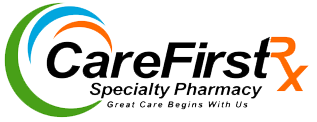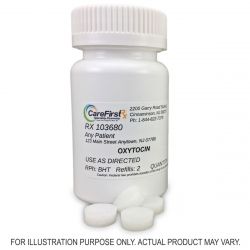Use of Oxytocin in the Treatment of Autism
Use of Oxytocin in the Treatment of Autism
By Casey Battersby, PharmD Candidate 2020
July 16th, 2019
CareFirst Specialty Pharmacy
Oxytocin is a naturally occurring peptide hormone in the human body that is produced by the hypothalamus. This hormone plays a role in human social bonding, sexual reproduction, and childbirth. Currently, a synthetic form of oxytocin is used as a medication to help induce labor in patients who are medically indicated and to help control postpartum bleeding. It is available as a solution for intramuscular (IM) and intravenous (IV ) injection.
Oxytocin is reported to be generally well tolerated. Some potential adverse effects include nausea and vomiting as well as water retention due to the drug’s anti-diuretic properties. The fluid intake and outtake of patients receiving oxytocin should be adequately monitored during the duration of use as they are at risk for water intoxication if they begin to retain too much water. Oxytocin should also be used with caution in patients with cardiovascular disease as there are potential cardiovascular complications.
Recently, oxytocin has been studied for use in patients with Autism Spectrum Disorder (ASD). ASD is defined as a biologically based neurodevelopmental disorder characterized by persistent deficits in social communication and social interaction and restricted, repetitive patterns of behavior, interests, and activities. ASD affects approximately 1 in 59 children in the United States.
Since oxytocin is known to play a role in social interactions between human beings, researchers first began the theoretical study that oxytocin could aid in improving the social interactions in patients with ASD. In 2003, doctors studied the effect of oxytocin infusion in 15 adult patients with autism. They observed the patients’ repetitive behaviors prior to infusion and then monitored and recorded any differences in post-infusion. They found that there was a significant reduction in repetitive behaviors post oxytocin infusion. A similar study occurred in 2010 that evaluated social interactions pre and post use of oxytocin in 13 patients with ASD, only this time they used inhaled oxytocin to make it more pleasant for the patients to receive the medication. The study found that when they observed the patients’ social behaviors post oxytocin administration, there was a statistically significant difference compared to the patient’s baseline, healthy subjects, and the placebo. Additionally, this study measured the patients’ oxytocin plasma concentrations prior to administration of the drug and found them to be significantly lower than the levels of healthy patients. Post administration, the patients who received inhaled oxytocin showed increases in plasma oxytocin concentrations 10 minutes after inhalation which researchers correlated to the increased positive social responses.
In 2017, psycho-endocrinologists found that patients with ASD had lower neuropeptide receptor mRNA levels for the neuropeptides oxytocin and arginine vasopressin compared to controls. The decrease in these receptor levels appears to be correlated with greater symptom severity, i.e., social impairments and stereotyped behaviors, but are seemingly unrelated to intellectual impairment. This finding suggests that lower neuropeptide receptor availability can serve as a biomarker in patients with ASD to evaluate for disease presence and symptom severity.
Around the same time as the discovery of the biomarker, intranasal oxytocin went through its first clinical trial for safety and efficacy. This study involved 31 children with diagnosed ASD and the drug was studied as a 12 International Unit (IU) nasal spray, given twice a day for five weeks. Results of the study found that there were significant improvements in the primary outcome of caregiver-rated social responsiveness in the oxytocin group compared to the placebo group. This study also found the nasal spray to be well tolerated with the most common reported side effects being thirst, urination, and constipation. A later study then evaluated different doses of intranasal oxytocin, comparing 8 IU/day with 24 IU/day in patients with ASD. There was no significant difference in response between the two study groups, leading the researchers to conclude that low dose oxytocin nasal spray has the same efficacy as the higher dosage.
Most recently, there was a study evaluating the use of intranasal oxytocin in ASD patients comparing their response to their pretreatment oxytocin plasma levels. It was found that patients with lower pretreatment oxytocin plasma levels had a greater response than patients whose levels were not as low. This leads to the conclusion that intranasal oxytocin use is most beneficial with ASD patients that have recorded low plasma levels rather than patients with ASD that have a normal oxytocin baseline (compared to healthy individuals).
Since oxytocin is not yet available commercially as a nasal spray for behavior improvements in ASD, patients and caregivers can request that a prescription for the nasal spray be sent to a compounding pharmacy. Carefirst Specialty pharmacy is a compounding pharmacy that ships to 38 US States and territories. We are located at 2200 Garry Road, Suite 1, Cinnaminson, New Jersey 08077 and can be contacted via phone at 844-822-7379.
References
- https://www.drugbank.ca/drugs/DB00107
- Oxytocin. Lexicomp Online, Hudson, Ohio: Wolters Kluwer Clinical Drug Information, Inc.; 2019; July 18, 2019.
- World Health Organization. The ICD-10 Classification of Mental and Behavioural Disorders. Clinical descriptions and diagnostic guidelines. https://www.who.int/classifications/icd/en/bluebook.pdf (Accessed on March 28, 2018).
- https://www.autismspeaks.org/science-news/cdc-increases-estimate-autismsprevalence- 15-percent-1-59-children
- Oztan O, Jackson LP, Libove RA, et al. Biomarker discovery for disease status and symptom severity in children with autism. Psychoneuroendocrinology 2018. 89:39-45.
- Hollander E, Novotny S, Hanratty M, et al. Oxytocin Infusion Reduces Repetitive Behaviors in Adults with Autistic and Asperger's Disorders. Neuropsychopharmacology 2003. 28: 193–198.
- Andari, E., Duhamel, J., Zalla, T., Herbrecht, E., Leboyer, M., Sirigu, A., & Ungerleider, L. Promoting Social Behavior with Oxytocin in High-Functioning Autism Spectrum Disorders. Proceedings of the National Academy of Sciences of the United States of America 2010. 107(9), 4389-4394.
- Yatawara CJ, Einfeld SL, Hickie IB, et al. The effect of oxytocin nasal spray on social interaction deficits observed in young children with autism: a randomized clinical crossover trial. Molecular Psychiatry 2016. 21:1225–1231.
- Parker KJ, Oztan O, Libove RA, et al. Intranasal oxytocin treatment for social deficits and biomarkers of response in children with autism. Proceedings of the National Academy of Sciences Jul 2017. 114 (30):8119-8124.


Comments